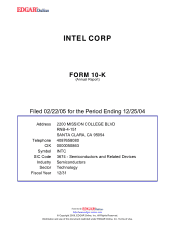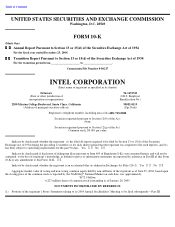Intel 2004 Annual Report Download - page 10
Download and view the complete annual report
Please find page 10 of the 2004 Intel annual report below. You can navigate through the pages in the report by either clicking on the pages listed below, or by using the keyword search tool below to find specific information within the annual report.
Table of Contents
We are working toward the convergence of computing and communications in the mobile handheld computing market segment by
developing technology that combines baseband communications features with memory and application processing functionality. Our “system-
in-a-package” processors, which are designed for PDAs, feature an Intel XScale technology-based processor stacked directly on top of Intel
StrataFlash memory chips in a single package. With stacked packaging, manufacturers of handheld devices can decrease the size of the form
factor, as well as help reduce their time-to-market.
We offer baseband chipsets for multi-mode, multi-band wireless handsets. These chipsets support multiple wireless standards and deliver
enhanced voice quality and high-integration capability, with optimized power consumption.
Communications Infrastructure Products
Our communications infrastructure components include products such as network and embedded processors, as well as optical
components. In network processing, we deliver products that are basic building blocks for modular communications platforms. These products
include advanced, programmable processors used in networking equipment to rapidly manage and direct data moving across the Internet and
corporate networks. We also offer embedded processors that can be used for modular communications platform applications as well as for
industrial equipment and point-of-sale systems.
Unlike proprietary system platforms, modular communications platforms are standards-based solutions that offer network infrastructure
builders flexible, low-cost, faster time-to-market options for designing their networks. Our network processor products are based on the Intel
®
Internet Exchange Architecture (Intel
®
IXA). At the core of Intel IXA is the Intel XScale microarchitecture, which offers low power
consumption and high-performance processing for a wide range of Internet devices.
In October 2004, we announced the Intel
®
IXP460, Intel
®
IXP465, Intel
®
IXP2325 and Intel
®
IXP2350 network processors. These
products are designed for traditional communications applications and for the emerging embedded networking segment. The Intel IXP2325 and
Intel IXP2350 processors are Intel’s first network processors built using our 90-nanometer process technology.
For embedded processors, our product families include the Intel Celeron and Intel
®
Pentium
®
III processors, the Intel Pentium M
processor, the Mobile Intel
®
Pentium
®
4 Processor-M and the Intel Pentium 4 processor. We also offer Intel Xeon processors with HT
Technology, providing increased performance for wireless infrastructure equipment.
In June 2004, we introduced the Intel Pentium M processor 745 for the communications infrastructure, designed for a range of wireline
and wireless infrastructure solutions, as well as Advanced Telecommunications Architecture* (ATCA*) board designs. ATCA is a modular
communications platform solution for building standards-based wireless base station equipment and high-speed interconnect technologies such
as PCI Express and Advanced Switching.
Wired and Wireless Connectivity Products
Ethernet is an industry-standard technology used to translate and transmit data in packets across networks. As Ethernet has expanded
from the traditional local area network (LAN) environment into the wireless LAN (WLAN), metropolitan area network (MAN) and networked
storage market segments, we have expanded our product portfolio to address these other market segments. For the MAN market segment, we
offer products at multiple levels of integration to provide a low-cost solution with increased speed and signal transmission distance (commonly
referred to as “reach”). Gigabit Ethernet networks allow the transmission of one billion individual bits of information per second, and 10-
Gigabit Ethernet networks transmit 10 billion bits of information per second. By contrast, Fast Ethernet networks transmit 100 million bits of
information per second (Mbps, or megabits per second).
In May 2004, we introduced a 10-Gigabit Ethernet adapter for servers, the Intel
®
PRO/10GbE SR Server Adapter, designed to lower the
costs of setting up a scalable, networked data center.
In January 2004, we introduced the Intel PRO/Wireless 2200BG Network Connection, a dual-mode product supporting the 802.11b and
802.11g forms of WiFi. In August 2004, we introduced the Intel
®
PRO/Wireless 2915ABG Network Connection, which supports all three
current forms of WiFi: 802.11a, b and g. Support for these three wireless technologies enables notebook PCs based on Intel Centrino mobile
technology to establish wireless connections with all currently available WiFi network types.
Networked Storage
In the networked storage market segment, we offer products that allow storage resources to be added in either of the two most prevalent
types of storage networks: Ethernet or Fibre Channel.
7























